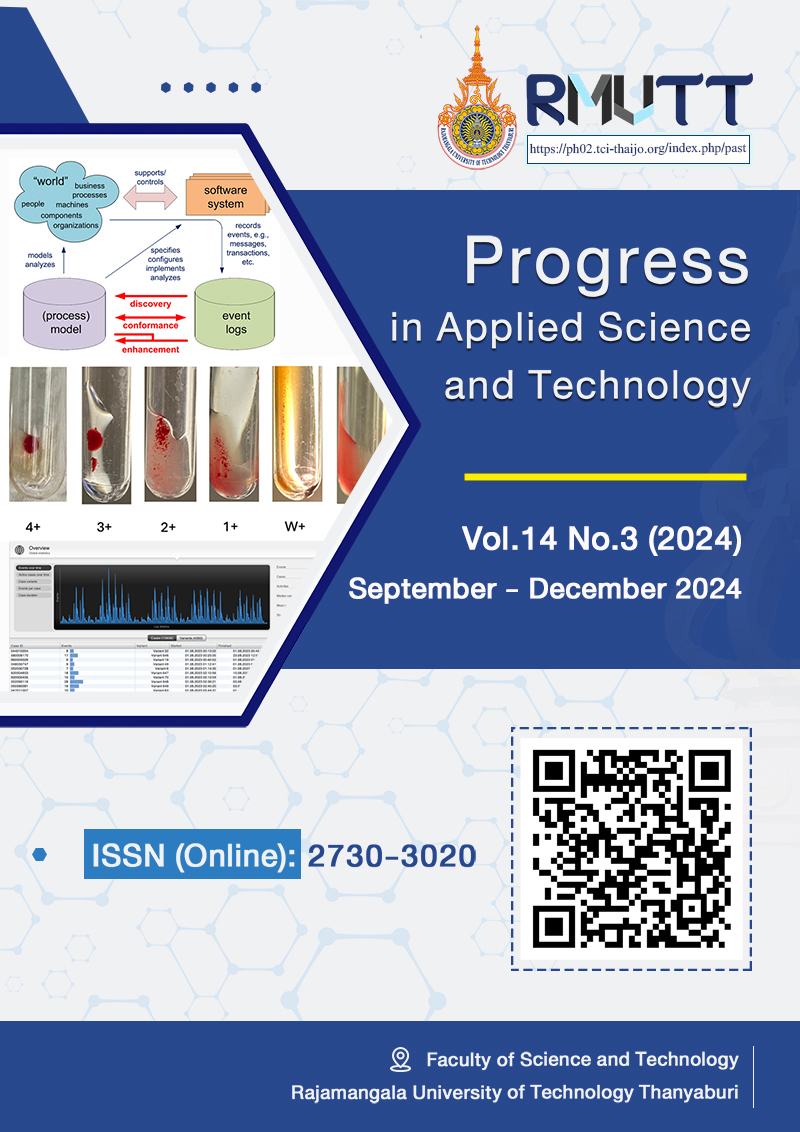Thai Vegetable Extracts Affecting Human Red Blood Cell Surface Antigens in the ABO Blood Group System
Main Article Content
Abstract
Plant proteins capable of agglutinating human red blood cells (RBCs) extend beyond traditional lectins to include ribosome-inactivating proteins (RIPs), antimicrobial peptides (AMPs), and various defense proteins. While these proteins have been extensively studied in legumes, their presence and activity in common vegetables remain largely unexplored. Understanding their distribution and specificity could reveal novel tools for glycobiology and human ABO blood typing applications. This study aimed to evaluate the agglutination activity of nine Thai vegetable extracts against human red blood cells, determine their ABO blood group specificity, and assess the correlation between protein content and agglutination strength. Additionally, we sought to identify potential plant proteins contributing to the observed agglutination patterns. In this study, crude protein extracts were prepared from nine different vegetables using phosphate-buffered saline (PBS) with pH 7.4. Total protein concentration was quantified using the Biuret method. Agglutination assays were performed using standardized human RBC suspensions from different blood groups. The specificity and strength of agglutination were evaluated using serial dilutions under controlled conditions. Among the nine extracts tested, five demonstrated significant agglutinating activity with varying specificities. Three extracts (L. polychrous mushroom, mulberry leaf, and winged bean) showed non-specific agglutination across all blood groups, suggesting the presence of broadly reactive proteins. Notably, D. biflorus seed and lima bean extracts exhibited specific agglutination against blood group A, indicating potential blood-type-specific proteins. Four extracts (C. serratum leaf, cucumber, L. leucocephala seed and long bean) showed no detectable agglutination activity. This study reveals previously unreported agglutinating activities in common vegetable extracts, with some showing blood group specificity. The diverse agglutination patterns observed suggest the presence of both lectin and non-lectin proteins with distinct binding properties. While these findings indicate potential applications in ABO blood typing and glycobiology research, further protein characterization and improved quantification methods are needed. Future studies should focus on isolating and identifying the specific proteins or lectin responsible for the observed agglutination patterns.
Article Details

This work is licensed under a Creative Commons Attribution-NonCommercial-NoDerivatives 4.0 International License.
References
Buathong R, Duangsrisai S. Plant ingredients in Thai food: a well-rounded diet for natural bioactive associated with medicinal properties. PeerJ. 2023;11:e14568.
Gorakshakar AC, Ghosh K. Use of lectins in immunohematology. Asian. J. Transfus. Sci. 2016;10:12-21.
Reid ME, Bird GW. Associations between human red cell blood group antigens and disease. Transfus. Med. Rev. 1990;4:47-55.
Rodríguez-Yoldi MJ. Anti-inflammatory and antioxidant properties of plant extracts. Antioxidants (Basel). 2021;10:921.
Gelberg H. Pathophysiological mechanisms of gastrointestinal toxicity. Compr. Toxicol. 2018:139-78.
Mpiana PT, Ngbolua KN, Bokota MT, Kasonga TK, Atibu EK, Tshibangu DS, Mudogo V. In vitro effects of anthocyanin extracts from Justicia secunda Vahl on the solubility of haemoglobin S and membrane stability of sickle erythrocytes. Blood. Transfus. 2010;8(4):248-54.
Ouattar H, Zouirech O, Kara M, Assouguem A, Almutairi SM, Al-Hemaid FM, Rasheed RA, Ullah R, Abbasi AM, Aouane M, Mikou K. In vitro study of the phytochemical composition and antioxidant, immunostimu lant, and hemolytic activities of Nigella sativa (Ranunculaceae) and Lepidium sativum seeds. Molecules. 2022;27:5946.
Ruiz-Cruz S, González-Vega RI, Robles-Zepeda RE, Reyes-Díaz A, López-Elías JA, Álvarez-Ainza ML, Cinco-Moroyoqui FJ, Moreno-Corral RA, Wong-Corral FJ, Borboa-Flores J, Cornejo-Ramírez YI, Del-Toro-Sánchez CL. Association of different ABO and Rh blood groups with the erythroprotective effect of extracts from Navicula incerta and their anti-inflammatory and antiproliferative properties. Metabolites. 2022;12:1203.
Sangvanich P, Kaeothip S, Srisomsap C, Thiptara P, Petsom A, Boonmee A, Svasti J. Hemagglutinating activity of Curcuma plants. Fitoterapia. 2007;78:29-31.
Sharon N, Lis H. History of lectins: from hemagglutinins to biological recognition molecules. Glycobiology. 2004;14:53-62.
Zubcevic N, Suljević D, Focak M, Rukavina D. Effects of plant lectins on human erythrocyte agglutination. Serbian. J. Exp. Clin. Res. 2016;17:1-1.
Wu AM, Dudek A, Chen YL. Recognition factors of Dolichos biflorus agglutinin (DBA) and their accommodation sites. Glycoconj. J. 2023;40:383-99.
Sultana MJ. Preparation of low cost affinity chromatographic matrix and its application in purification of a lectin isolated from mulberry seeds. Int. J. Biomed. Mater. Res. 2018;6:50-5.
Schertz KF, Jurgelsky W, Boyd WC. Inheritance of Anti-A1 hemagglutinating activity in lima beans, Phaseolus lunatus. Proceedings of the National Academy of Sciences of the United States of America 1960;46:529-32.
Sarkar S, Mondal M, Ghosh P, Saha M, Chatterjee S. Quantification of total protein content from some traditionally used edible plant leaves: A comparative study. J. Med. Plants. Stud. 2020;8:10.
Rudrappan RB, Veeran K. Role of plant-based lectins in identifying rare Bombay blood group. Polym. J. 2016;8:70.






